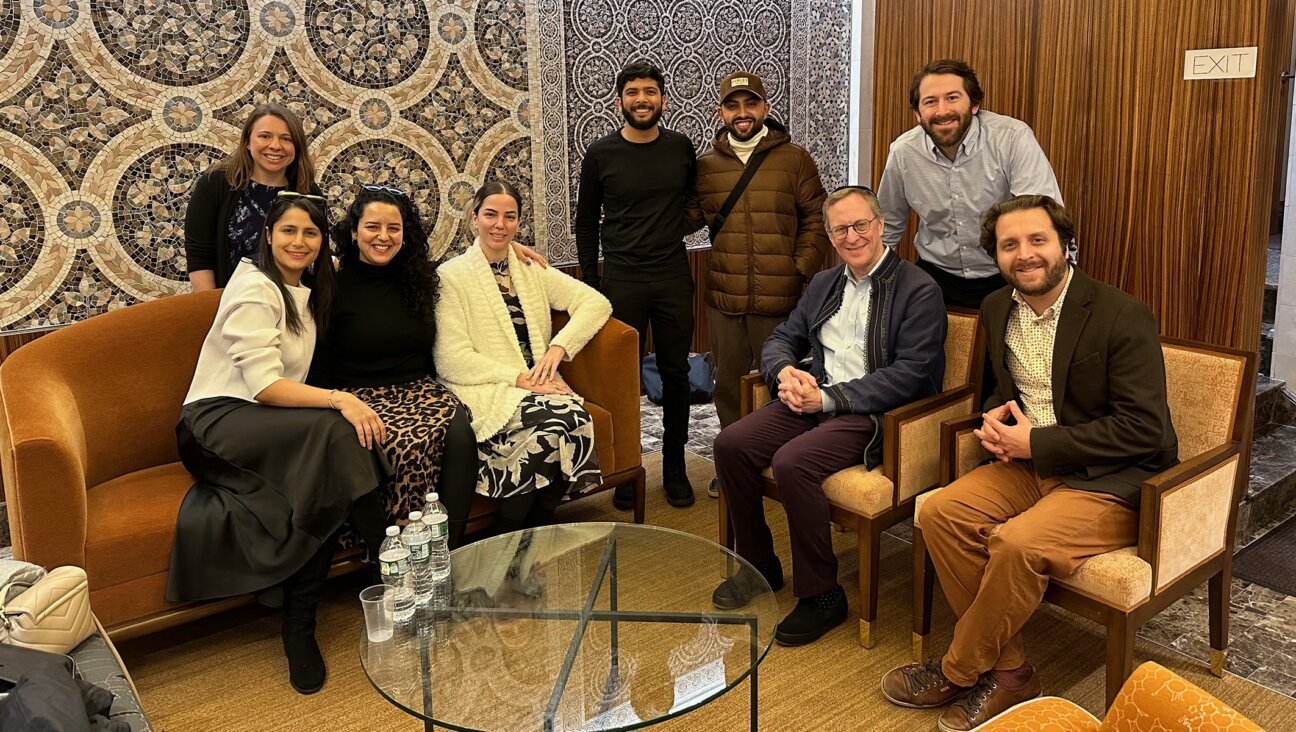Jewish Paganism: Oxymoron or Innovation?
I was skinny-dipping in the mud springs on the shores of the Dead Sea with Rabbi Ohad Ezrahi, a longhaired renegade kabbalist who runs a commune in the Judean Desert. We were enveloped by the softest, silkiest mud I’ve ever felt — it was like moving through thick cream. Then the rabbi told me to dive down as deep as I can go. When we each came up for air, he said, “At this moment, you are penetrating Mother Earth at her deepest place.”
So this is Jewish paganism: naked, covered in mud, communing with the God (or Goddess) in nature. It’s sensual, it’s controversial, and it’s the polar opposite of the reserved, dressed-up brand of Judaism that fills many synagogues. And thanks to a new generation of young rabbis, it seems to be growing.
If you’re like me, you probably associate paganism with everything opposed to Judaism: polytheism, idolatry, nature spirits and human sacrifice — just to name a few. Literally, though, the word “paganism” simply means the practices of rural people; the word comes from the Latin paganus, meaning country dweller. More substantively, it refers to religious beliefs and practices that are centered on the natural world, and on experiencing the various energies of that world with the body, mind, heart and spirit. Of course, with that broad a definition, much of Judaism is itself “pagan” — which is precisely what today’s Jewish “neo-pagans” claim.
“Paganism is fundamentally about relationships — with trees, fire, earth, air, spirits and other people,” Ezrahi said. “It’s about not seeing the world as an object, but seeing it as alive.” For some in the Jewish community, this translates into rituals celebrating the “Divine feminine” (which the Kabbalah has been doing for centuries anyway). For others, it means cultivating “eros,” which can mean anything from love and sexuality to more general notions of life force.
For Rabbi Jill Hammer, whose organization, Tel Shemesh, is dedicated to “celebrating and creating Earth-centered rituals within Judaism,” contemporary paganism is actually nothing new. Contrary to those who say that paganism equals idolatry, or that “pagan Judaism” is no different from, say, the messianic Judaism of Jews for Jesus, Hammer argues that “paganism has always been part of Judaism. The rabbis in the Talmud are worried about idolatrous objects, but they do magical spells. They’re involved in the same things they would consider pagan if other people did them.” What troubled the rabbis, Hammer said, was not the pagan practices themselves, but their propensity to lead people to avodah zara, or foreign worship.
As an example, Hammer cited the kabbalistic notion of the four worlds and four souls, which correspond to the “pagan” four seasons and four elements. Of course, Kabbalah always has struck its critics as smacking of paganism, but according to Hammer, the roots run deeper: “Paganism is a human impulse, whether you’re monotheistic or polytheistic. People experience divinity through their experience.” Tel Shemesh’s Web site, www.telshemesh.org, includes rituals for invoking water spirits and the four winds, poetry (including — by way of full disclosure — some of mine) and a Jewish calendar centered on the solstices and equinoxes.
As we sat in New York City’s Central Park, Hammer told me that she was never inspired by the Hanukkah menorah as a symbol of freedom. “But then I experienced taking a single candle and over eight days letting it grow to eight candles, just as the sunlight grows after the winter solstice. The earth is teaching me, and connected to my tradition. And I have that experience in my life — of being in a dark place, and then, God willing, the world becomes light again.”
Hammer paused as she told me this story. The wind blew, and some hippies played “Imagine” over in Strawberry Fields. And then Hammer said, “I get mad at the rabbis for making Hanukkah about a war, when it’s really about something that matters in our lives.”
Ezrahi had similar reservations about the classical rabbinic move away from what he calls a “balance” between paganism and prophetic ethics in the Bible. He said that if we could resurrect King David and see what his religion was like — dancing naked in front of the ark, composing love-drenched poetry for God in nature — he might seem pagan, too.
But what about idolatry? “The world is full of living forces,” Ezrahi replied. “Avodah zara — idolatry — is when you give power to those forces, when you think that each thing has its own power, separate from the One.” The way Ezrahi explains it, monotheism is “a second stage after the experience of being a pagan. If you don’t experience paganism, your monotheism is more an ideology than a religious experience. First you have to know that there is a spirit in the tree, and in the river, and in the sky. Then you can know that it’s really all one spirit.”
So how does this play out in practice?
At one extreme, there are kibbutzim re-enacting the harvest holidays, Jewish gatherings at festivals in Israel and America, even Jewish shamanism. For example, Rabbi Gershon Winkler is the director of the Walking Stick Foundation, which trains students to become shamanic healers; his Web site says that “Rabbi Winkler introduces us to the animals, colors, powers, spirits, elements and attributes of the four directions, and how to incorporate them into the varying situations of our personal life journey.” Winkler and his students, including Rabbi Menachem Cohen, leader of the Jewish community at the Burning Man festival, run “spirit-journeying” rituals in which participants invoke the four winds and focus their minds on the different “energies” of those directions in order to heal themselves.
Then there are those who emphasize the “pagan” content of existing Jewish rituals. Tashlich, for example, is the cleansing, renewing ritual of throwing breadcrumbs — symbolizing the “sins” of the last year — into a body of water. For many Jews, this is a faintly ridiculous custom. But for Amichai Lau-Lavie, the flamboyant founder and artistic director of Storahtelling: Jewish Ritual Theater Revised, it is a primal, pagan act of community expiation. One year, he said, “we created a show based on the narrative of the scapegoat, which was a very pagan ritual done in our tradition with very unclear origins, in which one of the goats goes to the demon of demons, and thus the community is cleansed and the year can start again. So we re-enacted this story, and then we walked down to the Hudson River at 47th Street with a lot of people and drums and doing the conscious act of throwing it into the water, feeding the fish, getting rid of your past. Is that pagan or is it Jewish? Call it what you want.”
Another time, Lau-Lavie orchestrated a three-day festival based on Simchat Beit Hashoeva, originally an elaborately choreographed symbolic rain ritual. The Talmud records that it frequently was so raucous that it led to wanton sex. In Lau-Lavie’s re-creation, it included “fire juggling, chanting, music, yoga, and bodywork [massage, reiki, etc.]. On the night of the full moon, we built a huge spiral of candles the size of half a football field, and sang the 15 songs of ascents. We were praying to the four directions with the Arba’ah Minim (the four species conventionally known as the lulav and etrog). It doesn’t get any more pagan than that — but regular Jews do it all the time.”
Well, sort of. Traditional Jews “do” a deliberately watered-down, domesticated version of these rituals, within boundaries circumscribed by Halacha. Even if Judaism does have pre-monotheistic roots, is getting back to those roots still “Jewish”? Or is it getting back to exactly what we were supposed to get away from?
For Rabbi Mordechai Gafni, a controversial, charismatic rabbi with two best-selling books and an Israeli television program, it all depends on how paganism is put into context. For Gafni, paganism was the essence of biblical Jewish practice. But, he said, “we need to distinguish between ‘level one’ paganism and this new, ‘level three’ paganism. Level one is the idea in its raw form, and it was rejected by level two, which is the religion of the prophets. The prophets saw that level one paganism was all about eros, with its power and passion. There was no ethics. The prophets rejected that. They said, ‘God’s primary demand is ethical behavior.’ And the prophets are right. But level three both transcends and includes level two. We don’t get rid of prophetic ethics, but we move from that place to eros. We reclaim eros, the energy of Shechinah, the energy of the goddess, and unite it with ethics.”
Ezrahi, who recently co-authored a book with Gafni on the myth of Lilith, told a similar story. “The Talmud is full of sages talking to rivers, trees, birds. But in [Tractate] Sanhedrin it says, we don’t want to be pulled to idolatry, and we are willing to ‘pay the price’ of prophecy to avoid it. ”
Since then, Ezrahi added, the pagan parts of the Talmud were minimized and marginalized by rationalistic rabbis. “We thought that we became smart. We are scientific people, and we know these things don’t happen. Actually, we became blind, deaf and arrogant.”
As a result, Gafni said, our culture has gotten so devoid of spirit that paganism is needed to rescue ethics itself. “All ethical failure comes from a lack of eros. When you’re moved to act unethically, what is happening? You’re responding to a primal insecurity. In order to be ethical, we have to be in eros. Bonfires, chanting, ecstatic dance, embodied ritual — all recapture divine energy,” Gafni said.
But, I asked the rabbi, how do we know that we’re not in danger of precisely that which so many sacred texts warn about? The answer, he said, is ethics. “You know it’s holy eros because it leads to ethics. People help each other, work with each other. That’s the litmus test.” And the opposite? “A KKK rally,” Gafni answered. “Lots of bonfires, lots of energy. No ethics. That’s the distinction between holy paganism and idolatry.”
So are these new “pagan rabbis” reviving ancient Jewish traditions — or creating a new heresy? Perhaps time will tell. On the one hand, drum circles, sweat lodges and shamanic invocations are certainly not the Judaism I grew up with in suburban Florida. On the other hand, young people are leaving that Judaism in record numbers. Maybe, I thought one late afternoon in Jerusalem, there really is something to all this earth-based religion, after all. But then the setting sun let me know it was time for evening prayers.

















